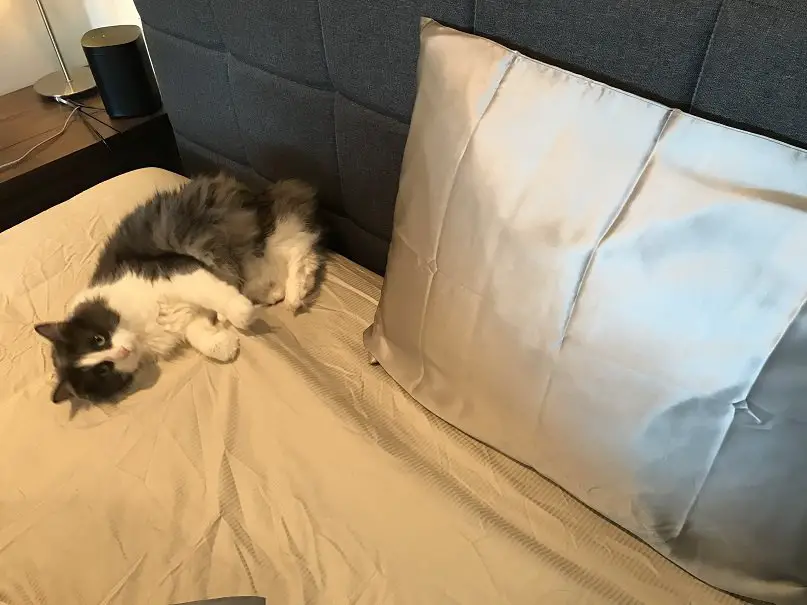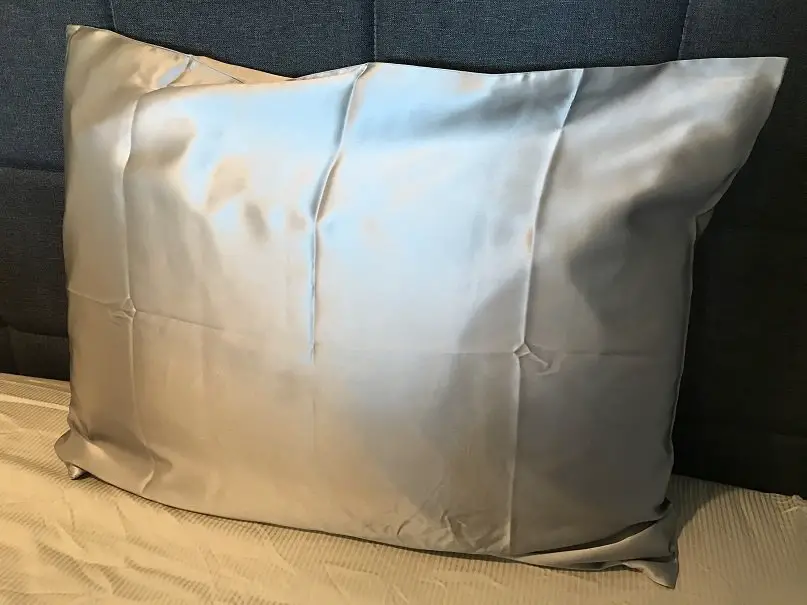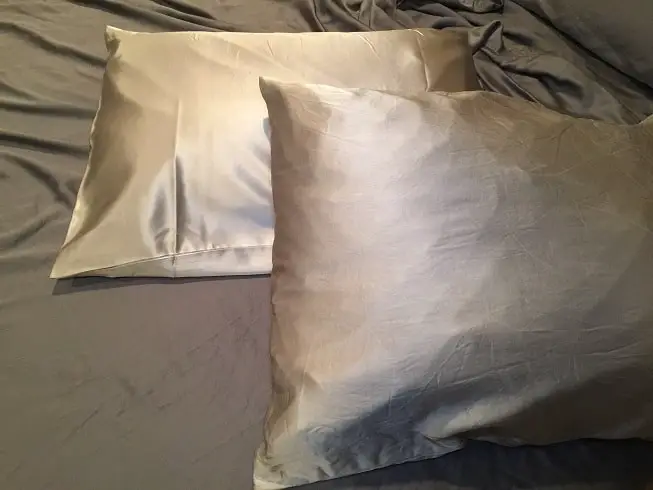Table of Contents
**This page contains affiliate links and I will be compensated if you make a purchase after clicking on my links**
Like all of you, I love the feel of silk. Not only does it feel cool to the touch, but its moisture-wicking and breathable properties make it an ideal bedding material for hot sleepers like me.
But silk requires care. It’s generally recommended that it be hand-washed in cold water.
As a generally busy person, I can’t be bothered. If something can’t be machine-washed, then it’s not for me.
In addition, I have allergies in addition to mild asthma. Allergists—including my own—recommend washing all bedding in hot.
Not warm, hot (≥ 130 F or 54 C).
But the problem with hot water and natural fibers is that when exposed to the former, the latter tend to shrink. This is obviously an issue with clothing, but perhaps not so critical for bedding.
Likewise, the agitation of machine washing can break delicate fibers, such as silk, and change the look and feel of the fabric.
When I tried machine washing silk in hot water, this is what I found:
Slight shrinkage and a minor loss of shine, but otherwise intact
Why washing in hot water is important for allergy and asthma sufferers
Hot water will kill 100% of dust mites.
Dust mites are those microscopic insect-like creatures that take up residence in moist places, like our bedding, live off the dead skin that we constantly slough off, and reproduce like mad. Many people are highly allergic to them.
(If your allergy or asthma symptoms worsen at night, this could be you—see your allergist. Likewise, if your skin becomes red or itchy, possibly from atopic dermatitis—see your allergist.)
If your allergist informs you that you react to dust mites you need to remove two things from your bedding: 1) the dust mites, and 2) the allergens left by the dust mites.
Dust mites aren’t the only thing that leaves allergens. Your furry friends may also be to blame.
Removing allergens is straightforward and happens simply by washing your bedding with detergent. In a study by Tovey, et. al. (2001) they compared washing in different temperatures with different detergents and measured the removal of dust mite allergen (Der p 1) and cat allergen (Fel d 1).
Simple washing in a “moderate” temperature with detergent was enough to remove most of the allergens. Interestingly hot water did better to remove the dust mite allergen as it denatures, or breaks apart, at high temperatures. In contrast, cat allergen is stable at high temperatures.
Washing in hot water isn’t just for bedding. If you spend any time outdoors (or leave your windows open) you’re picking up pollen from plants and grasses that can also aggravate allergy and asthma symptoms.
If you can, machine wash everything on hot!
If you can’t wash bedding in hot water
You’re not going to put grandma’s quilt into your washing machine. You may have bedding that you simply can’t machine-wash on hot. Here are some alternatives for removing dust mites and their allergens.
- According to WebMD, wash in warm (86-104 F, or 30-40 C), then rinse twice on cold
- According to the National Institute of Environmental Health Sciences, place your bedding in the freezer overnight. This will kill the dust mites, but it won’t remove the allergens already there.
- According to the Mayo Clinic, first, place your bedding in the dryer and dry on hot (≥ 130 F or 54 C) to kill the dust mites, then wash and dry as usual to remove the allergens
- A steam clothing system may also kill dust mites. But again, may not necessarily remove allergens
- According to the Allergy and Asthma Foundation of America, dry cleaning kills 100% of dust mites
However, according to a study by Watanabe, et.al. (1995), dry-cleaning is NOT as effective as hot water washing when it comes to the removal of allergens.

Pets also enjoy the feel of silk. (Photo by author.)
Silk bedding
Silk is a luxury fabric that not only looks and feels nice but is far superior to cotton in its ability to absorb and wick moisture (sweat) away from you. As a result, you stay cooler.
The second benefit of a wicking fabric, such as silk, as that moisture doesn’t sit around and encourage a breeding ground for the aforementioned dust mites.
Because of its slippery feel, pillowcases made of silk allegedly prevent “bed head”. Likewise, there may be less tug from the fibers on your hair, which may help if you are prone to hair loss. (As I am not prone to either of these issues, I couldn’t tell you if these claims are accurate.)
There is some evidence that silk may have benefits for both your hair and skin.
Regardless, silk certainly feels nice.
Silk is made by the silkworm. The most common is mulberry silk, which is made by the mulberry silkworm that feeds on, you guessed, it mulberry leaves.
Silk fabric doesn’t have a thread count. Instead, thread density is measured by momme. A momme of 19-25 is considered high quality and is available for bedding. The higher the momme, the thicker and more durable the silk cloth.
- Pet warning: cats also enjoy the feel of silk. When they enjoy something, they like to “knead” it. Silk is very susceptible to tiny pulled threads from tiny claws. The silk is still quite functional, but it simply doesn’t look as nice.
The washing experiment
Because I’m not made of money, I started with two 21-momme mulberry silk pillowcases, purchased from my favorite online store.
They are very lovely to sleep on, with a nice cool feel.

Right out of the package, silk bedding comes folded and will have tell-tale fold lines. If that bothers you, you’ll need to iron them. (Turn inside out, and use the cool setting only.) Photo by author.
Here are the care instructions that came with the product, that I will mostly ignore (edited for better English):
Washing:
- Turn inside out (“backside washing”)
- Dry clean or gently wash by hand with mild detergent or silk special detergent in cold water (below 30 C, which is 86 F)
- It’s better to wash separately from other items
- Don’t bleach
- If machine washing, use the delicate cycle plus a mesh washing bag to avoid scratching or snagging
Drying:
- Dry inside out
- Don’t wring dry. Wrap the silk pillowcases in a dry towel to remove most of the water. Roll out the pillowcase and straighten gently at the corners
- Don’t tumble dry
- Air dry (avoid exposure to direct sunlight)
- Cool iron from the backside of the pillowcase, or place one piece of cloth inside
It’s always a good idea to wash delicate items inside out or place them in a mesh bag. However, from a practical standpoint, I’m most likely to forget. My pillowcases will go into the wash as is.
I have a regular High-Efficiency front-loading washer I purchased from Sears back in 2006. No special bells or whistles.
For those of you familiar with HE washers, you know they are very good a removing most of the wetness during the final spin cycles. Depending on your current humidity level, machine-drying may be optional.
(Thanks to strong Santa Ana desert winds, I’m currently experiencing humidity levels close to zero. Clothing dries almost instantly.)
I do have a delicate cycle, but for the sake of water conservation, I never wash anything on its own.
These pillowcases will get thrown in with my regular wash; “normal/casual” cycle wash on hot followed by rinsing on cold. Like all the rest, they’ll be washed with Tide pods “free & gentle”.
I’ll catch them before they land in the drier and air dry them flat as recommended.
(However, in the future I may likely forget… I expect even more shrinkage may result.)
The results

Original pillowcase in the back; washed pillowcase in the front. Neither has been ironed. The washed silk is still clearly silk, but slightly duller. (Photo by author.)

For comparison, the washed pillowcase has been laid on top of the original pillowcase. Note the shrinkage at left. (Photo by author.)
The pillowcase itself came out fine: seams and zippers are intact.
The silk material is slightly wrinkly with a “crushed” look. As a result, it has lost a bit of that silk shine, but it’s still clearly silk.
I don’t own an iron, but I suspect ironing would help restore some of its former glory.
If I had followed the instructions and hand-washed or used the delicate cycle I’m sure it would eventually take on the crushed look. It would probably take several more washes first.
The biggest concern was the expected shrinkage. This won’t be a concern if your pillows run on the small size. Flat sheets will be fine.
Shrinkage could definitely be a concern with a fitted sheet.
Update
I’ve now been consistently machine-washing these pillowcases over the last several months, and they have been holding up fine.
As noted above, there was some shrinkage with the first wash, but none on subsequent washes.
I lay them flat to dry. Unlike the moisture-hogging cotton that we’re all used to, silk dries very quickly.
In summary, yes, you can wash silk in hot water without destroying it. It is a natural fiber after all. However, you will get shrinkage and the special silk shine will be a bit muted.
BONUS video: Can you Machine-Wash Silk?
Another update: What detergent should you use to wash silk?
Silk is a glycoprotein called fibroin. Many ingredients in conventional laundry detergent are designed to break down protein, as proteins make up many stains.
Never use chlorine bleach on silk. Likewise, avoid oxygen bleach, and alkaline (high pH) additives such as sodium carbonate (“washing soda”), baking soda, or Borax®.
Another thing to avoid are enzymes, that again, are included to break apart stains.
If you are concerned, there is detergent available that is specifically designed to wash silk.
Alternatively, look up the ingredients in your favorite laundry product. Many companies have listed them at smartlabel.org.
It turns out my “Free & Gentle” detergent isn’t exactly gentle. Included in the ingredients is the enzyme subtilisin, which breaks down protein.
Oops…
I’m not too concerned, as my cats will destroy my silk pillowcases long before the detergent does.
However, I did note that the silk texture subtly changed with washing. Was this due to the laundry detergent, the mechanical forces of the spin cycle, or something else…
Want to learn more about the products mentioned?
[If you experience issues with menus or links not working, it is most likely due to your Ad blocker.]


